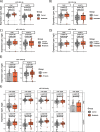Can circulating microRNAs predict colorectal cancer? Results from a nested case-control study of pre-diagnostic serum samples from two prospective biobanks
- PMID: 40082755
- PMCID: PMC11905635
- DOI: 10.1186/s12885-025-13854-1
Can circulating microRNAs predict colorectal cancer? Results from a nested case-control study of pre-diagnostic serum samples from two prospective biobanks
Abstract
Background: This study aimed to investigate the potential of circulating small RNAs (sRNAs) as predictive biomarkers for future colorectal cancer (CRC). The study analyzed serum samples from pre-diagnostic CRC patients in two prospective biobanks.
Methods: Serum samples from 142 pre-diagnostic CRC patients, from the Finnish Maternity Cohort (FMC) and The HUNT Study (HUNT2), were subjected to small RNA sequencing. The study compared sRNA expression in CRC cases with controls, considering diverse sRNA classes.
Results: Analysis revealed diverse miRNA expression patterns with notable variations in future metastatic cases. Specifically, miR-223-3p and miR-21-5p showed significant up-regulation in future metastatic cases in the FMC cohort. Consistent changes were observed across cohorts, with miR-584-5p, miR-30c-5p, miR-146a-5p, miR-10a-5p, and miR-1306-5p showing up-regulation in future metastatic cases.
Conclusions: The study identified potential serum miRNA biomarkers associated with metastatic CRC, though statistical significance varied. These findings contribute to the understanding of miRNA profiles in pre-diagnostic CRC patients, emphasizing the need for further exploration of non-invasive biomarkers in large prospective studies.
Keywords: Biomarkers; Colorectal Neoplasms; Diagnosis; MicroRNAs; Serum.
© 2025. The Author(s).
Conflict of interest statement
Declarations. Ethics approval and consent to participate: The study was approved by “REK midt (REC central)”, Norwegian University of Science and Technology, Trondheim Norway, ( https://rekportalen.no/#omrek/REK ) with reference 2016/534. All participants provided informed consent as participants in the health surveys. Consent for publication: Not applicable. Competing interests: The authors declare no competing interests.
Figures


References
-
- Sung H, et al. Global cancer statistics 2020: GLOBOCAN estimates of incidence and mortality worldwide for 36 cancers in 185 countries. CA Cancer J Clin. 2021;71:209–49. 10.3322/caac.21660. - PubMed
-
- Morson BC. The evolution of colorectal carcinoma. Clin Radiol. 1984;35:425–31. 10.1016/s0009-9260(84)80033-1. - PubMed
-
- O’Brien MJ, Gibbons D. The adenoma-carcinoma sequence in colorectal neoplasia. Surg Oncol Clin N Am. 1996;5:513–30. - PubMed
-
- Petrelli F, et al. Prognostic survival associated with left-sided vs right-sided colon cancer: a systematic review and meta-analysis. JAMA Oncol. 2017;3:211–9. 10.1001/jamaoncol.2016.4227. - PubMed
MeSH terms
Substances
LinkOut - more resources
Full Text Sources
Medical

